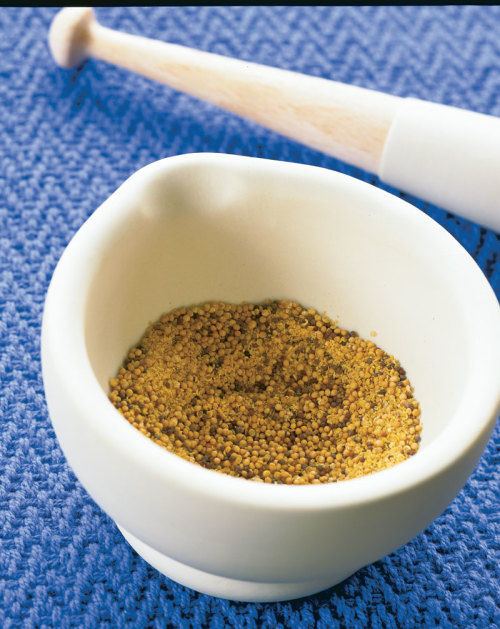
Mustard seeds can be ground in a blender, but a coffee grinder works much better. You can, of course, use a mortar and pestle and do as the ancients did: sift the powder through a piece of fine silk. Note that most commercial dry mustard is cut with flour and colored with turmeric, and will not look—or taste—the same as your homemade version.
A word of warning: Keep your distance when grinding the seeds. The substance that makes mustard hot—allyl-isothiocyanate—will irritate your eyes and nose if you get too close. When mustard seeds are crushed and mixed with water, they release volatile oils which act like capsaicin, the hot component of chile peppers.
Freshly prepared mustard is the hottest and most pungent, and typically you need to allow mustard to age for at least a couple of weeks. You can easily manipulate the firepower of your mustard by adjusting heat, cold, and time. Heat tempers the spiciness, while cold preserves it. Time mellows mustard, though mellowing is slowed by refrigeration.
For maximum heat, mix the ingredients, place in sterile jars, cover tightly, and refrigerate immediately. A slice of lemon placed on top of the mustard in a jar will help preserve the kick. For a milder punch, allow mustard to age for two to eight weeks at room temperature, then refrigerate. The longer it stands, the milder it will be and the better the flavors will blend. The mildest mustards are those that are cooked, then allowed to age at room temperature. This is why many recipes that call for the addition of mustard to a sauce will direct you to add it at the last minute, because longer cooking will destroy its pungency.
Seeds can be ground partially or fully for prepared mustard recipes, or added to beets, cucumbers (fresh and pickled), green tomatoes, snap beans, cabbage, cole slaw, pickled onions, sauerkraut, relishes, chutneys, and homemade sausages. Add 1⁄2 teaspoon of mustard seeds to the cooking water for broccoli, Brussels sprouts, and cabbage to enhance flavor.
Use dry mustard as a base for prepared mustard, or add to mayonnaise, salad dressing, barbecue sauce, meatballs, or pâtés. Mustard will stabilize and bind food and emulsions; i.e., it will keep a hollandaise sauce or mayonnaise from breaking.
| More about mustard:
• How to Grow Mustard |
|
Here are a few things to keep in mind when working with mustard in the kitchen. About ten mustard flowers yield 1⁄4 cup seeds, which in turn yields 1 cup prepared mustard; two or three plants will provide you with this. Vinegar and the acidic component of mustard will react with aluminum bowls and utensils, giving mustard a metallic taste. Be sure to use wooden spoons and stainless steel or non-stick pans, and always store mustards in glass or ceramic containers.
The longer mustard sits, the more liquid the ground seeds will absorb, up to seven times their weight. Add liquid as necessary to get the consistency you like.
For variety, add a tablespoon of any of the following to each cup of prepared mustard: horseradish, minced chile peppers, capers, minced sun-dried tomatoes, grated fruit peel, chopped pickle, or minced fresh dill, basil, sage, mint, or thyme.
However you choose to use this ancient herb, you’ll find this tiny seed surely lives up to its reputation as a vigorous grower in the garden and a full-flavored character in the kitchen.
by LeAnn Zotta
February 1999
from Fine Gardening #19

















Comments
Log in or create an account to post a comment.
Sign up Log in